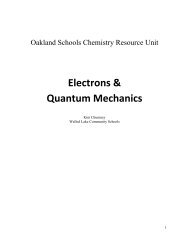Phase changes of water - Oakland Schools
Phase changes of water - Oakland Schools
Phase changes of water - Oakland Schools
You also want an ePaper? Increase the reach of your titles
YUMPU automatically turns print PDFs into web optimized ePapers that Google loves.
KINETIC MOLECULAR THEORY<br />
Activity #2--Homemade Ice Cream Lab<br />
Questions to be investigated:<br />
Is freezing an exothermic or endothermic reaction?<br />
Objectives:<br />
C2.2B Describe the various states <strong>of</strong> matter in terms <strong>of</strong> the motion and arrangement <strong>of</strong><br />
the molecules (atoms) making up the substance.<br />
C4.3B Recognize that solids have a more ordered, regular arrangement <strong>of</strong> their particles<br />
than liquids and that liquids are more ordered than gases.<br />
C5.4d Explain why freezing is an exothermic change <strong>of</strong> state.<br />
Teacher Notes:<br />
Ice Cream is simply a tasty way to observe scientific principles. The first concept is a<br />
phase change or the movement from one state <strong>of</strong> matter to another. The three primary<br />
states <strong>of</strong> matter we study are solids, liquids, and gases. Solids are tightly packed atoms<br />
that have rigid bonds that do not flow. Solids have a fixed volume and shape. Liquids<br />
are bound together, but not as tightly packed and their bonds are more flexible allowing<br />
them to flow. Liquids have a fixed volume, but their shape is the same as their<br />
container. Gases are loosely packed molecules that flow freely. Gases have an indefinite<br />
volume and shape because they take the volume and shape <strong>of</strong> their container.<br />
The second principle observed in the ice cream lab is the transfer <strong>of</strong> heat in a system.<br />
The two types <strong>of</strong> heat transfer are endothermic and exothermic reactions. Endothermic<br />
reactions remove heat from the surrounding environment into the primary system.<br />
Exothermic reactions remove heat from the primary system and transfer it to the<br />
surrounding environment. In either case, the Law <strong>of</strong> Conservation <strong>of</strong> Energy is applied.<br />
Heat is a form <strong>of</strong> energy and it is neither created nor destroyed in a reaction, it merely<br />
<strong>changes</strong> form or location.<br />
Materials: (per group):<br />
1-gal Ziploc bag or plastic container (4) 1-qt Ziploc bags<br />
5 cups ice 1 cup rock salt<br />
3 cups milk (3/4 cup/person) 16 tsp sugar (4 tsp/person)<br />
4 tsp vanilla (1 tsp/person) 4 spoons (1/person)<br />
Source: Chemistry: Chapter 16--Homemade Ice Cream Lab:<br />
http://www.mvhs.fuhsd.org/mia_onodera/chemistry%20documents/l<br />
abs%202007-2008/lab%2028%20chapter%2016-<br />
%20Ice%20Cream%20Lab%2008.doc<br />
Ice Cream Lab, Adapted from UVA Physics Department:<br />
http://www.school.cdfarmsite.com/labs/icecreamlab0506.doc<br />
14
















